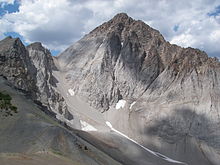| Idaho Batholith | |
|---|---|
| Stratigraphic range: Cretaceous to Paleogene | |
| Type | Pluton |
| Lithology | |
| Primary | Granite and Granodiorite |
| Other | Quartz diorite and Tonalite |
| Location | |
| Region | Central Idaho |
| Country | |


The Idaho Batholith is a granitic and granodioritic batholith of Cretaceous-Paleogene age that covers approximately 25,000 square kilometres (9,700 sq mi) of central Idaho and adjacent Montana. The batholith has two lobes that are separate from each other geographically and geologically. The Bitterroot lobe is the smaller lobe and the larger lobe is the Atlanta lobe. The Bitterroot lobe is in the north and is separated from the larger Atlanta lobe in the south by the Belt Supergroup metamorphic rocks that compose the Salmon River Arch.[1] Much of the Atlanta and Bitterroot lobes are in the Idaho Batholith ecoregion.[2]
The overall intrusive event that created the Idaho batholith lasted for around 55 million years from Late Cretaceous to the Eocene (98 to 43 Ma) of magmatism and includes the younger Challis suite which is not considered to be part of the Idaho Batholith.[3] The Challis suite intruded both the Atlanta and Bitterroot lobes of the Idaho Batholith as well as the surrounding areas to the east of the Atlanta lobe.[3] The Challis suite is more petrologically diverse and contains a range of rocks from gabbro to granite.[3][4]
- ^ Cite error: The named reference
:2was invoked but never defined (see the help page). - ^ "Ecoregions of Idaho" (PDF). U.S. Environmental Protection Agency. Archived (PDF) from the original on April 18, 2021. Retrieved December 22, 2014.
- ^ a b c Cite error: The named reference
:3was invoked but never defined (see the help page). - ^ Gaschnig, Richard M.; Vervoort, Jeffrey D.; Lewis, Reed S.; Tikoff, Basil (2011). "Isotopic Evolution of the Idaho Batholith and Challis Intrusive Province, Northern US Cordillera". Journal of Petrology. 52 (12): 2397–2429. doi:10.1093/petrology/egr050. ISSN 1460-2415.

